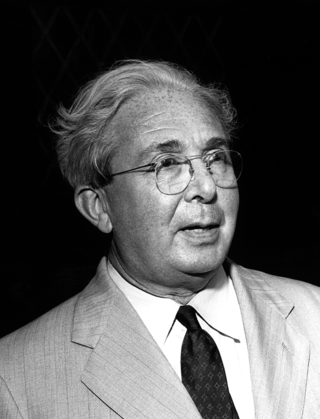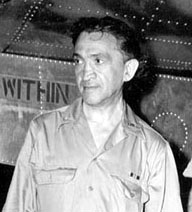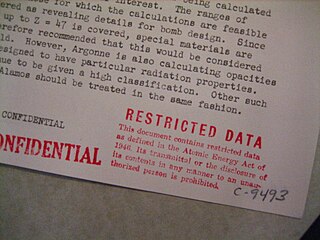Related Research Articles

A nuclear weapon is an explosive device that derives its destructive force from nuclear reactions, either fission or a combination of fission and fusion reactions, producing a nuclear explosion. Both bomb types release large quantities of energy from relatively small amounts of matter.

Edward Teller was a Hungarian-American theoretical physicist who is known colloquially as "the father of the hydrogen bomb" and one of the creators of the Teller–Ulam design. Teller was known for his scientific ability and his difficult interpersonal relations and volatile personality.

Leo Szilard was a Hungarian-American physicist and inventor. He conceived the nuclear chain reaction in 1933, patented the idea in 1936, and in late 1939 wrote the letter for Albert Einstein's signature that resulted in the Manhattan Project that built the atomic bomb. According to György Marx, he was one of the Hungarian scientists known as The Martians.

Trinity was the code name of the first detonation of a nuclear weapon, conducted by the United States Army at 5:29 a.m. MWT on July 16, 1945, as part of the Manhattan Project. The test was of an implosion-design plutonium bomb, nicknamed the "gadget", of the same design as the Fat Man bomb later detonated over Nagasaki, Japan, on August 9, 1945. Concerns about whether the complex Fat Man design would work led to a decision to conduct the first nuclear test. The code name "Trinity" was assigned by J. Robert Oppenheimer, the director of the Los Alamos Laboratory, inspired by the poetry of John Donne.

The Federation of American Scientists (FAS) is an American nonprofit global policy think tank with the stated intent of using science and scientific analysis to attempt to make the world more secure. FAS was founded in 1946 by scientists, including some who worked on the Manhattan Project, to develop the first atomic bombs. The Federation of American Scientists states that it aims to reduce the amount of nuclear weapons that are in use, and prevent nuclear and radiological terrorism. It says it aims to present high standards for nuclear energy's safety and security, illuminate government secrecy practices, as well as track and eliminate the global illicit trade of conventional, nuclear, biological and chemical weapons.

Ben Roy Mottelson was an American-Danish nuclear physicist. He won the 1975 Nobel Prize in Physics for his work on the non-spherical geometry of atomic nuclei.

The Smyth Report is the common name of an administrative history written by American physicist Henry DeWolf Smyth about the Manhattan Project, the Allied effort to develop atomic bombs during World War II. The subtitle of the report is A General Account of the Development of Methods of Using Atomic Energy for Military Purposes. It was released to the public on August 12, 1945, just days after the atomic bombings of Hiroshima and Nagasaki on August 6 and 9.

Nazi Germany undertook several research programs relating to nuclear technology, including nuclear weapons and nuclear reactors, before and during World War II. These were variously called Uranverein or Uranprojekt. The first effort started in April 1939, just months after the discovery of nuclear fission in Berlin in December 1938, but ended only few months later, shortly ahead of the September 1939 German invasion of Poland, for which many notable German physicists were drafted into the Wehrmacht. A second effort under the administrative purview of the Wehrmacht's Heereswaffenamt began on September 1, 1939, the day of the invasion of Poland. The program eventually expanded into three main efforts: Uranmaschine development, uranium and heavy water production, and uranium isotope separation. Eventually, the German military determined that nuclear fission would not contribute significantly to the war, and in January 1942 the Heereswaffenamt turned the program over to the Reich Research Council while continuing to fund the activity.

Samuel Abraham Goudsmit was a Dutch-American physicist famous for jointly proposing the concept of electron spin with George Eugene Uhlenbeck in 1925.

Philip Morrison was a professor of physics at the Massachusetts Institute of Technology (MIT). He is known for his work on the Manhattan Project during World War II, and for his later work in quantum physics, nuclear physics high energy astrophysics, and SETI.

Kenneth Tompkins Bainbridge was an American physicist at Harvard University who worked on cyclotron research. His accurate measurements of mass differences between nuclear isotopes allowed him to confirm Albert Einstein's mass–energy equivalence concept. He was the Director of the Manhattan Project's Trinity nuclear test, which took place July 16, 1945. Bainbridge described the Trinity explosion as a "foul and awesome display". He remarked to J. Robert Oppenheimer immediately after the test, "Now we are all sons of bitches." This marked the beginning of his dedication to ending the testing of nuclear weapons and to efforts to maintain civilian control of future developments in that field.

Samuel King Allison was an American physicist, most notable for his role in the Manhattan Project, for which he was awarded the Medal for Merit. He was director of the Metallurgical Laboratory from 1943 until 1944, and later worked at the Los Alamos Laboratory — where he "rode herd" on the final stages of the project as part of the "Cowpuncher Committee", and read the countdown for the detonation of the Trinity nuclear test. After the war, he returned to the University of Chicago to direct the Institute for Nuclear Studies and was involved in the "scientists' movement", lobbying for civilian control of nuclear weapons.

William Leonard Laurence was a Jewish American science journalist best known for his work at The New York Times. Born in the Russian Empire, he won two Pulitzer Prizes. As the official historian of the Manhattan Project, he was the only journalist to witness the Trinity test and the atomic bombing of Nagasaki. He is credited with coining the iconic term "Atomic Age," which became popular in the 1950s. Infamously, he dismissed the destructive effects of radiation sickness as Japanese propaganda in The New York Times. Even though he had seen the effects first-hand, he had been on the War Department payroll, and was asked by United States military officials to do so in order to discredit earlier reports by independent journalist Wilfred Burchett, the first reporter on-site after the bombings.

The Making of the Atomic Bomb is a history book written by the American journalist and historian Richard Rhodes, first published by Simon & Schuster in 1987. The book won multiple awards, including Pulitzer Prize for General Non-Fiction. The narrative covers people and events from early 20th century discoveries leading to the science of nuclear fission, through the Manhattan Project and the atomic bombings of Hiroshima and Nagasaki.

Restricted Data (RD) is a category of proscribed information, per National Industrial Security Program Operating Manual (NISPOM). Specifically, it is defined by the Atomic Energy Act of 1954 as:
William Asahel Shurcliff was an American physicist.

Nukemap is an interactive map using Mapbox API and declassified nuclear weapons effects data, created by Alex Wellerstein, a historian of science at the Stevens Institute of Technology who studies the history of nuclear weapons. The initial version was created in February 2012, with major upgrades in July 2013, which enables users to model the explosion of nuclear weapons on virtually any terrain and at virtually any altitude of their choice. A variation of the script, Nukemap3D, featured rough models of mushroom clouds in 3D, scaled to their appropriate sizes.

Albert Wattenberg, was an American experimental physicist. During World War II, he was with the Manhattan Project's Metallurgical Laboratory at the University of Chicago. He was a member of the team that built Chicago Pile-1, the world's first artificial nuclear reactor, and was one of those present on December 2, 1942, when it achieved criticality. In July 1945, he was one of the signatories of the Szilard petition. After the war he received his doctorate, and became a researcher at the Argonne National Laboratory from 1947 to 1950, at Massachusetts Institute of Technology from 1951 to 1958, and at University of Illinois at Urbana–Champaign from 1958 to 1986, where he pursued studies related to the atomic nucleus.
African-American scientists and technicians on the Manhattan Project held a small number of positions among the several hundred scientists and technicians involved. Nonetheless, African-American men and women made important contributions to the Manhattan Project during World War II. At the time, their work was shrouded in secrecy, intentionally compartmentalized and decontextualized so that almost no one knew the purpose or intended use of what they were doing.

John Coster-Mullen was an American industrial photographer, truck driver and nuclear archaeologist who played an important role in creating a public record of the design of the first atomic bombs. He is known for his critically-acclaimed self-published book Atom Bombs: The Top Secret, Inside Story of Little Boy and Fat Man.
References
- 1 2 "Alex Wellerstein :: Stevens Institute of Technology :: About". Alexwellerstein.com. Retrieved 18 August 2017.
- ↑ "Alex Wellerstein". Atomicheritage.org. Retrieved 18 August 2017.
- ↑ "Alex Wellerstein - Belfer Center for Science and International Affairs". Belfercenter.org. Retrieved 18 August 2017.
- ↑ "Alex Wellerstein Faculty Website". Stevens Institute of Technology. 2021-11-18. Retrieved 2021-11-18.
- ↑ "Curriculum Vitae". Alex Wellerstein. Retrieved 2023-01-20.